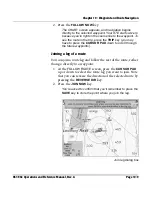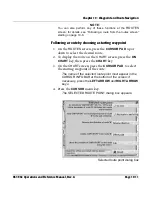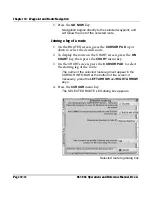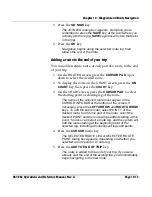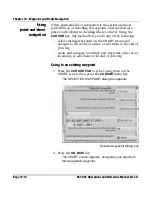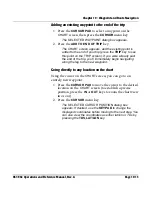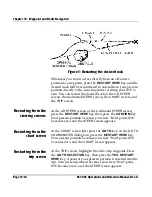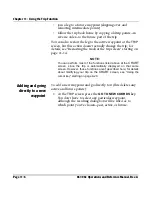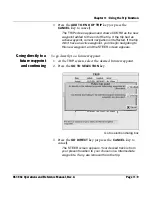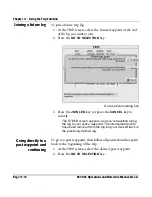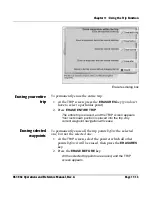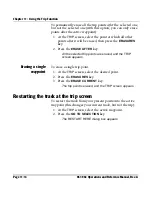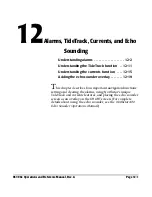
Chapter 11 - Using the Trip Function
Page 11-2
961/962 Operations and Reference Manual, Rev. A
Introducing the trip function
What is the trip?
The trip is
a sequence of past, active, and future waypoints.
Like a route, the trip consists of a series of waypoints, but
unlike a route, a trip occurs in real time—as you travel. Each
waypoint that you navigate to is automatically recorded in the
trip.
If you’re navigating to a waypoint and you decide to go to a
different waypoint, the 961/962 removes the original point
from the trip and adds the new point instead, ensuring that the
record of the trip remains accurate. Whenever you navigate
directly to a waypoint, any future points in the trip are erased
and replaced by the new point. Whenever you add a waypoint
to end of the trip, you’ll go to any future waypoints before the
new one.
You can erase single points from the trip, or erase the entire
trip. You can save the trip at any time as a route in the
database. Overall, the trip function provides a quick and easy
way to check on your progress as well as make changes while
you travel.
Of course, you can navigate while ignoring the trip function.
You may want to ignore trip functions while learning to use
the system.
You might consider erasing the trip at the beginning of
each day.
The trip can’t “fill up” unless there are 250 future points in it.
Even when full, the trip automatically wraps around so that
the oldest points, but never active or future ones, are thrown
away to make room for the new ones.
Why use the trip?
The trip function has three major benefits:
•
it creates a record of today’s trip by automatically adding
to the trip each waypoint that you navigate to—even those
waypoints that weren’t part of your original route or
trip—including
*MOBXX*
and
*SAVEDXX*
waypoints (and
coordinates, shown as
COORD
, that you navigate to based
on the echo sounder’s function, if used)
The trip is a sequence of
waypoints comprising a
particular
journey-in-progress: a
record of waypoints,
coordinates, and routes
showing where you’ve been
and where you intend to go.
In contrast, a route is a
sequence of waypoints
that’s stored in the
database.
Summary of Contents for 961
Page 6: ...Page viii 961 962 Operations and Reference Manual Rev A ...
Page 8: ...Page x 961 962 Operations and Reference Manual Rev A ...
Page 14: ...Page xvi 961 962 Operations and Reference Manual Rev A ...
Page 92: ...Chapter 3 Using the Controls Page 3 34 961 962 Operations and Reference Manual Rev A ...
Page 160: ...Chapter 6 Creating Waypoints Page 6 18 961 962 Operations and Reference Manual Rev A ...
Page 176: ...Chapter 7 Creating Avoidance Points Page 7 16 961 962 Operations and Reference Manual Rev A ...
Page 202: ...Chapter 8 Creating Routes Page 8 26 961 962 Operations and Reference Manual Rev A ...
Page 380: ...Glossary Page G 8 961 962 Operations and Reference Manual Rev A ...


